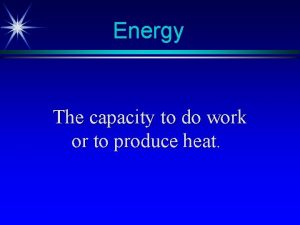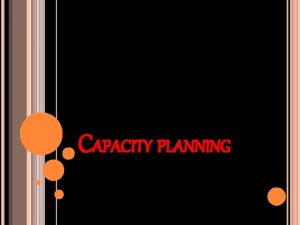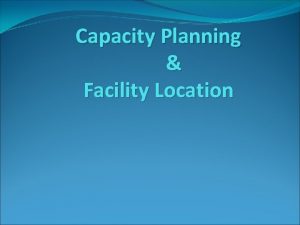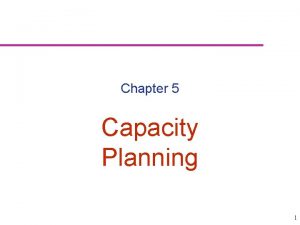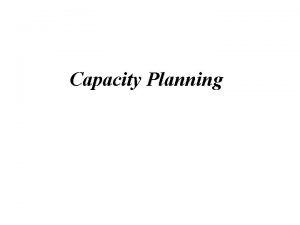Energy The capacity to do work Work n













- Slides: 13

Energy The capacity to do work

Work n Work = Force × displacement n Units: F(N) × d(m) = N·m 1 N·m = 1 Joule = 1 J And remember, 1 N = 1 kg·m/s 2 so 1 J = 1 kg·m 2/s 2

Energy n Energy is the capacity to do work When we do work on an object, we change its energy n Energy is conserved! It may be n transferred, it may be transformed, but it is never created or destroyed

Energy n We will consider two forms of energy n Potential Energy, PE, is stored energy PE = mgh Notice that mgh is weight times height. In other words, a force (weight) times a displacement (the height).

Potential Energy n If we lift a 10 kg box to a height of 3 m, by how much does its potential energy change? PE = mgh = (10 kg)(9. 8 m/s 2)(3 m) = 294 J

Energy n Kinetic energy, KE, is the energy of motion KE = ½mv 2 Notice the units work! kg × (m/s)2 = J

Energy n The total energy of an object is the sum of its potential and kinetic energy Etotal = PE + KE

Etotal = PE + KE

Example n A 20 kg object is at rest at the top of a 5 m high frictionless hill. n n What is its potential energy? What is its kinetic energy? What is its total energy? The object slides down the hill. As it slides, what happens to Etotal? KE? PE? its speed?

Example n When the object reaches the bottom of the hill n n what is is its its total energy? potential energy? kinetic energy? speed?

Example n When the object was sliding down the hill and was at a height of 2 m n n What was was its its total energy? potential energy? kinetic energy? speed?

Example n If we drop a 2 kg rock from a height of 30 m, how fast will it be going when it reaches the ground? Ignore air resistance.

Example n A 5 kg object is sliding 2 m/s at the top of a frictionless hill that is 3 m high. n n n What is the object’s total energy? What will be the object’s speed at the bottom of the hill? The object then slides up another frictionless hill that is 1. 2 m high. How fast will it be going at the top of this hill?
 Energy is the capacity to do work
Energy is the capacity to do work The capacity to do work.
The capacity to do work. Energy is the capacity to
Energy is the capacity to Energy is the capacity to do work.
Energy is the capacity to do work. Channel capacity planning
Channel capacity planning Energy energy transfer and general energy analysis
Energy energy transfer and general energy analysis Energy energy transfer and general energy analysis
Energy energy transfer and general energy analysis Work and energy section 2 describing energy answer key
Work and energy section 2 describing energy answer key Physics 03-01 work and the work-energy theorem
Physics 03-01 work and the work-energy theorem Chapter 4 work and energy section 1 work and machines
Chapter 4 work and energy section 1 work and machines Hình ảnh bộ gõ cơ thể búng tay
Hình ảnh bộ gõ cơ thể búng tay Ng-html
Ng-html Bổ thể
Bổ thể Tỉ lệ cơ thể trẻ em
Tỉ lệ cơ thể trẻ em

